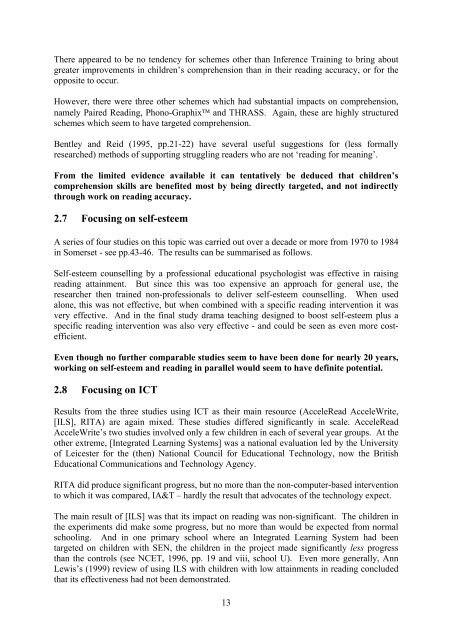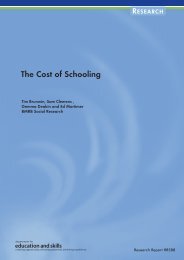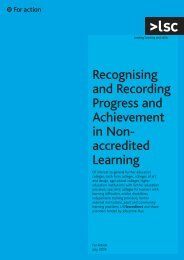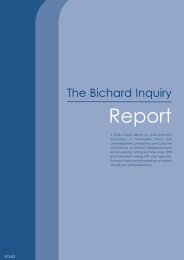What Works for Children with Literacy Difficulties? - Digital ...
What Works for Children with Literacy Difficulties? - Digital ...
What Works for Children with Literacy Difficulties? - Digital ...
Create successful ePaper yourself
Turn your PDF publications into a flip-book with our unique Google optimized e-Paper software.
There appeared to be no tendency <strong>for</strong> schemes other than Inference Training to bring about<br />
greater improvements in children’s comprehension than in their reading accuracy, or <strong>for</strong> the<br />
opposite to occur.<br />
However, there were three other schemes which had substantial impacts on comprehension,<br />
namely Paired Reading, Phono-Graphix and THRASS. Again, these are highly structured<br />
schemes which seem to have targeted comprehension.<br />
Bentley and Reid (1995, pp.21-22) have several useful suggestions <strong>for</strong> (less <strong>for</strong>mally<br />
researched) methods of supporting struggling readers who are not ‘reading <strong>for</strong> meaning’.<br />
From the limited evidence available it can tentatively be deduced that children’s<br />
comprehension skills are benefited most by being directly targeted, and not indirectly<br />
through work on reading accuracy.<br />
2.7 Focusing on self-esteem<br />
A series of four studies on this topic was carried out over a decade or more from 1970 to 1984<br />
in Somerset - see pp.43-46. The results can be summarised as follows.<br />
Self-esteem counselling by a professional educational psychologist was effective in raising<br />
reading attainment. But since this was too expensive an approach <strong>for</strong> general use, the<br />
researcher then trained non-professionals to deliver self-esteem counselling. When used<br />
alone, this was not effective, but when combined <strong>with</strong> a specific reading intervention it was<br />
very effective. And in the final study drama teaching designed to boost self-esteem plus a<br />
specific reading intervention was also very effective - and could be seen as even more costefficient.<br />
Even though no further comparable studies seem to have been done <strong>for</strong> nearly 20 years,<br />
working on self-esteem and reading in parallel would seem to have definite potential.<br />
2.8 Focusing on ICT<br />
Results from the three studies using ICT as their main resource (AcceleRead AcceleWrite,<br />
[ILS], RITA) are again mixed. These studies differed significantly in scale. AcceleRead<br />
AcceleWrite’s two studies involved only a few children in each of several year groups. At the<br />
other extreme, [Integrated Learning Systems] was a national evaluation led by the University<br />
of Leicester <strong>for</strong> the (then) National Council <strong>for</strong> Educational Technology, now the British<br />
Educational Communications and Technology Agency.<br />
RITA did produce significant progress, but no more than the non-computer-based intervention<br />
to which it was compared, IA&T – hardly the result that advocates of the technology expect.<br />
The main result of [ILS] was that its impact on reading was non-significant. The children in<br />
the experiments did make some progress, but no more than would be expected from normal<br />
schooling. And in one primary school where an Integrated Learning System had been<br />
targeted on children <strong>with</strong> SEN, the children in the project made significantly less progress<br />
than the controls (see NCET, 1996, pp. 19 and viii, school U). Even more generally, Ann<br />
Lewis’s (1999) review of using ILS <strong>with</strong> children <strong>with</strong> low attainments in reading concluded<br />
that its effectiveness had not been demonstrated.<br />
13

















